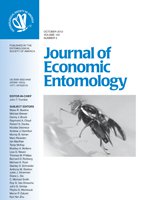In the quantitative estimation of the effectiveness of pesticides and repellents, Abbott's correction and similar methods have been used for nearly a century. However, the formulas for such corrections have some disadvantages in performing range estimations and being used in batched experiments. These disadvantages also exist in the estimation of EC50, the chemical concentration that produces 50% mortality. In this study, I propose as a solution to these problems a Bayesian estimation with a logistic model. This method enables the flexible modeling of non-normal variables in complex experimental design, for example, life-death response in a batched experiment. Furthermore, if any knowledge about focal phenomena exists, it can be used in analyses as a prior distribution, thus enhancing the accuracy of the estimation.
How to translate text using browser tools
1 October 2012
Bayesian Estimation for the Effectiveness of Pesticides and Repellents
K. I. Takakura
ACCESS THE FULL ARTICLE
It is not available for individual sale.
This article is only available to subscribers.
It is not available for individual sale.
It is not available for individual sale.

Journal of Economic Entomology
Vol. 105 • No. 5
October 2012
Vol. 105 • No. 5
October 2012
Abbott's formula
Bayesian statistics
EC50
range estimation
repellency




